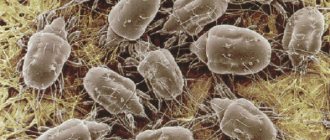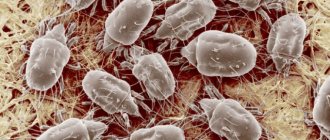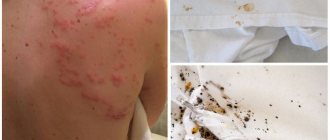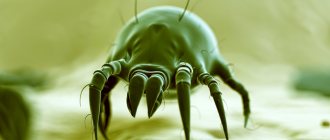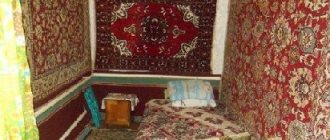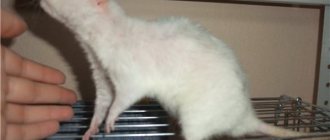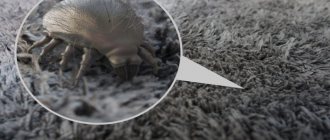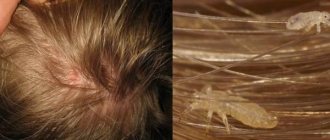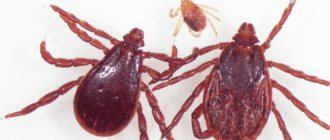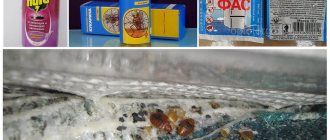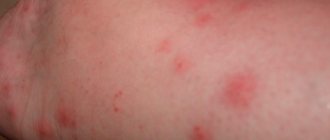Dust mites , or bed mites , are domestic parasites belonging to the arthropod family. Their habitat is dust, and their food source is dead human skin cells. Bed mites are unpretentious and can survive in almost any conditions. The most favorable environment for their living is warm and humid, the temperature is about 21 degrees Celsius, that is, the one that is installed in living quarters, and there is an abundance of food (epithelium). This explains their wide distribution.
Such parasites can cause allergies, and prolonged exposure to them can lead to the development of sinusitis and even asthma. In addition, the scabies mite provokes a disease such as scabies, which occurs with regular contact with its waste products.
That is why it is important to know what a tick that lives at home looks like and how to get rid of it.
You may be confusing dust mites with bed bugs or marks on your skin with bed bug bites.
Domestic mites (dust mites, also known as bed mites, furniture mites, linen mites, feather mites)
Knowledge about household ticks, what they look like and where they live in a private house or apartment will help you understand what to do with them. First of all, you will have to come to terms with the fact that it is impossible to kill all these uninvited guests, but it is quite possible to prevent the inhabitants of a living space in which bed mites have developed health problems caused by contact with these parasites.
Photo of the parasite under a microscope and its description
Dust mites, which are also called bed mites, furniture mites, mattress mites, linen mites, and feather mites, are so tiny in size that they can only be seen under a microscope. The size of its convex body rarely exceeds 0.5 mm. 4 pairs of legs equipped with suction cups are attached to the body. The outside of the bed mite is covered with a water-repellent layer. You can see what the parasite looks like in a photo taken in macro mode.
Today, science knows about more than 150 types of dust (bed) mites. The most dangerous for people are Dermatophagoides farinae (farina) and Dermatophagoides pteronyssinus (pteronyssinus).
Dust mite lifestyle
The linen mite starts in an apartment or private house, where it is warm and humid. According to various sources, the optimal temperature regime for the comfortable existence and reproduction of the parasite is 18–26°C. The ideal air humidity for a bed dweller is 55% or higher. These creatures have a relatively short lifespan of 65–80 days. During this period, the female manages to lay up to three hundred eggs.
If a hairy mite lives in flour, grain, plant and animal residues, then the dust mite starts:
- on bookshelves;
- in wardrobes;
- in bedding (pillows, blankets, blankets, bedspreads, mattresses);
- carpets made from materials of natural origin;
- in soft toys;
- on curtains and curtains;
- in magazines and books;
- in furniture upholstery;
- in deposits of old clothes;
- in places where dust accumulates (behind bookcases, wardrobes, furniture).
House ticks do not live alone, only in colonies. There can be up to tens of thousands of them in 1 g of dust. These mites are saprophytes, meaning they feed on dead organic matter. In Latin they are called "dermatophagoides". This means that they eat dead particles of human skin.
Main types of house ticks
House ticks are a separate biological group of parasites that live in the residential environment. They not only spoil food, clothing and furniture, but also affect the health of humans and animals.
The following types of ticks can appear and reproduce in the living environment:
- Hairy house tick . This pest lives in flour, grain, plant and animal residues, and even in cheese and tobacco. Such mites actively develop at a temperature of 23-25 degrees and a relative air humidity of 80-90%. They can cause dermatitis in humans;
- Scabies mite (itching) . It develops and parasitizes only on humans in high humidity and warmth. It is the causative agent of scabies;
- Rat mite . The parasite primarily attacks rats, but, in the absence of a natural host, can attack other mammals, as well as humans. Rat mites cause a difficult to treat disease - rat mite dermatitis. This parasite is common in rural areas and poses a danger to its inhabitants;
- Chicken mite . This type of parasite is widespread throughout the world. Mainly lives in nests and droppings of birds, cracks of wooden surfaces. Can parasitize on the surface of human skin, causing skin rashes and irritations;
- Bird mite . This tick parasitizes wild and domestic birds, that is, it lives in close proximity to humans and is capable of attacking them.
Household ticks are dangerous not only because of their bites, but also because of the impact of their own feces on humans and pets.
More about the parasite
One of the human companions, the linen or bed mite, lives for several hundred years and is distributed in all parts of the world. He feels comfortable with a person. It feeds on dead skin cells, dandruff, lost hair, hides in the folds of dirty bed linen, in pillows, blankets, mattresses and feels great in a dusty room that has not been cleaned for a long time.
Note! A person does not notice the presence of a bed mite if he has good immunity and does not know what an allergic reaction is.
Sensitive people have it more difficult. Their skin and respiratory organs respond to pest bites with endless runny nose, coughing, sneezing, and skin irritations in the form of a small red rash.
It is possible to examine a bed mite (it is a type of saprophyte) only with the help of a microscope, it is so small.
A tick (as we see it in photographs) looks like this:
- yellow-brown;
- the body is flattened, covered with chitin;
- length – from 0.2 to 0.6 mm;
- six limbs with suction cups;
- head in the shape of a triangle.
An adult tick lives for a month and a half, during which time the female lays more than three hundred eggs.
The best fillings for “pregnant” pillows
Expectant mothers need special comfort while sleeping or resting. Special pillows have been invented for them to support their growing belly at night.
It is better to choose a synthetic material as a filler - it does not cause allergies, which is very important for both mother and baby
Grass Textile Comforel – holofiber balls
4.8
★★★★★
editorial assessment
90%
buyers recommend this product
These soft balls are made of siliconized fiber and have a diameter of 1.5 to 2.5 cm. The filler is produced by a company from St. Petersburg. The material does not accumulate static electricity and does not cause allergies. It is light, soft and breathable.
Advantages:
- keeps its shape perfectly;
- Can be washed multiple times;
- can be pressed in gentle mode;
- durable;
- hypoallergenic.
Flaws:
- requires thorough rinsing, as it produces a lot of foam;
- After washing, the product must be straightened, otherwise it will take a long time to dry.
This filler is suitable for sewing pillows intended not only for pregnant women, but also for nursing mothers.
Theraline – polystyrene beads (EPS granules)
4.7
★★★★★
editorial assessment
86%
buyers recommend this product
This filler is produced by the German company Theraline and is especially recommended for expectant mothers. Small balls with a diameter of only 0.5 mm made of polystyrene are sometimes called “anti-stress balls”. Indeed, they have the ability to calm and relieve tension. The filler is odorless and has an excellent orthopedic effect. A 9 liter package is enough to fill a pillow of any size.
Advantages:
- European quality certificate;
- absolute safety;
- special device included for easy filling.
Flaws:
cannot be washed.
This material is ideal for expectant mothers to relieve stress and have a comfortable sleep.
Habitats
At home, ticks most often settle in beds. The main reason is the availability of food. Bed pests feed on particles of exfoliated skin and sweat. Optimal living conditions are warmth, humidity, and the absence of bright sunlight. In a person’s bed, all these conditions are met.
On a note!
Bed mites, when multiplying rapidly, can settle in other places in an apartment or house, hence the other names of parasites - sofa, mattress, furniture, dust.
Mattress mites settle in furniture, soft toys, interior items, and remain on any surface where a large layer of dust accumulates. It's safe to say that furniture mites are everywhere, always and everywhere. The ideal place is an unmade bed, an old mattress, feather pillows, unwashed bedding with particles of dandruff, skin, and sweat.
Bed or dust mites
Nutritional Features
An interesting feature of the diet of dust mites is that digestion most often occurs outside their body. For this purpose, they place spores of fungi of the genus Aspergillus on organic particles, which carries out the digestion process with the help of enzymes. And only after this the parasite eats the already processed food. As a result, fecal masses are formed, released into the external environment and containing specific proteins Der f1 and Der p1, which cause the destruction and death of human epidermal cells. These substances provoke the appearance of allergy symptoms in people who are prone to these diseases.
Fungal spores carried by ticks also pose a serious health risk. Therefore, at home, the most effective way to combat it is wet cleaning using detergents containing antifungal components.
Why are bites dangerous?
Ticks are capable of transmitting many viral and other diseases, but human infection does not occur during a bite. In any case, scientists have not been able to prove otherwise. Most likely, nature made sure that bed mites had a constant source of food. If a person becomes infected and dies, then ticks will be left without such a source.
Bed tick bites are not completely harmless. For example:
- The human body reacts in a very unique way to the bites of these parasites: severe itching, rashes on the body and other allergic reactions appear. Some people may experience angioedema, which can be fatal. Almost 80% of people on the planet exhibit various allergic reactions to bed tick bites.
- Some people, especially children, scratch their wounds, causing them to fester.
- Iron deficiency anemia may occur, especially in children, if bites occur quite often.
- These parasites do not allow a person to rest normally at night, disturbing the person’s mental balance. Nobody likes having parasites suck your blood every night.
Signs of bed bug infestation, where to look and how to kill them Watch this video on YouTube
Possible allergic reactions
Dust mites are the causative agents of severe allergic reactions. Their excrement actively affects the mucous membranes of the body and causes:
- Quincke's edema;
- conjunctivitis and rhinoconjunctivitis;
- allergic dermatitis;
- respiratory allergy;
- rhinitis;
- bronchial asthma.
These reactions can even lead to death.
It is easy to verify that such signs are associated with the presence of house dust. If signs do not appear outside the home and the person’s condition returns to normal, then the conclusion is obvious. In addition, you should pay attention to the period of regression, which occurs from August to October. It is during this period that dust mites actively reproduce, as well as in winter, when the apartment is rarely ventilated and all residents spend most of their time at home.
Following actions:
- Visit a doctor to clarify the diagnosis.
- If the cause of everything is a dust mite, then you need to do some general cleaning without wasting time.
- Subsequently, you will have to get rid of all the old, unnecessary things once and for all.
- Replace window textiles with aluminum blinds or other types of blinds that do not attract dust.
- Get rid of carpets on the walls and floors.
- Make sure that dust is removed with a vacuum cleaner every day.
- Wash and iron bedding and personal hygiene products in a timely manner.
What do bites look like?
To understand what caused the rashes, you need to know what exactly bed mite bites look like on human skin.
During a bite, the domestic parasite releases an anesthetic substance into the skin, so the bite itself is imperceptible. The effect of the anesthetic lasts 20 minutes, so the tick has time to make several bites and get enough of it.
Where the tick has bitten, a dot of dried blood appears, and redness of the skin is observed around the bite. When a bite is detected, it is important not to scratch the affected area to avoid infection.
For your information!
Bed ticks are nocturnal, and during the day they rest in secluded corners. If bites appear during the day, it means that other parasites are to blame, but not them.
Signs and symptoms of a bed tick bite
- Unlike a mosquito bite, which will leave behind 1-2 red dots, a tick bite leaves many marks that will be accompanied by itching and will be painful on palpation. In some cases, swelling appears at the bite sites.
- The itching is so severe that it cannot be ignored. If you compare it with the itching after a wasp sting, it is a little weaker.
- Compared to bedbug bites, tick bites are larger and the redness is much brighter. If you can see the bug, you won't be able to see the tick.
Bed tick bites have another distinctive feature: the center of the bite looks like a lump with dried blood. Ticks attack a person while he is fast asleep. This time period occurs between 3-5 am.
With a massive accumulation of parasites, the appearance of new tick bites can be observed almost every morning. Insects prefer to bite children and women. If a person sleeps without clothes, the tick runs from place to place, making bites and thus looking for a more favorable place for itself.
A considerable number of people are trying to understand that ticks have appeared in their apartment.
There are dust mites in every apartment, the only difference is their number.
To understand how many there are, it is recommended to pay attention to the following things.
- interior items. Long pile carpets are a great place for pathogens to grow. In this situation, even a vacuum cleaner will not save you; it will only help disperse them around the apartment. To ensure effective cleaning, it is recommended to buy a vacuum cleaner with a filter. It is recommended to wash curtains once a week, although no one does this.
- Feather pillows are an ideal breeding ground for mites. Oddly enough, they are also found in synthetic winterizers. The exception is silicone pillows.
- Mattress. The longer a mattress is used, the more mites it contains.
The presence of dust in the house, uncleaned and unwashed things, dirt on the floor indicate that the house is full of parasites.
Even based on a person’s health status, one can understand that there are ticks in the house.
Symptoms:
- fatigue for no apparent reason;
- constant sneezing, coughing;
- there is chronic weakness;
- labored breathing;
- desire to go outside as soon as possible;
- eyes itch and become red;
- decreased immunity;
- Tears often flow from the eyes;
- snoring at night;
- runny nose in the morning;
- after sleep you want to sleep again;
- insomnia;
- skin rashes.
Many people notice that they don't want to be in their own home. But why such a desire arises is not clear to them. They mainly refer to feeling unwell, which quickly passes if they find themselves in a different environment.
Harm
Unlike forest (street) ticks, domestic parasites do not dig into the human body, trying to get enough of his blood. The danger comes from the waste products of dust mites, which contain special digestive enzymes-proteins that cause various allergic reactions in people, manifested by:
- cough;
- irritation of the skin and mucous membranes;
- lacrimation;
- sneezing and chronic runny nose;
- redness in the throat;
- conjunctivitis.
Mites provoke the appearance of allergic rhinitis and dermatitis. The feces of dust mites that enter the human body along with dust dissolve on the mucous membranes, simultaneously dissolving the cells of the human body along with them, which leads to the aggressiveness of the immune system, associating the waste products of parasites as an allergen with the subsequent appearance of a strong allergic reaction.
For children
Parasites pose the greatest danger to small children who are short in stature and are forced to be relatively close to the floor. According to statistics, 70% of children suffering from bronchial asthma have an allergic reaction to bed mites found in carpeting, old books, furniture upholstery and notebooks. Asthma worsens most often in the autumn and spring.
According to the results of studies conducted by scientists at the University of Massachusetts, children living in rural areas are susceptible to dust mite allergies several times less than their urban peers. This, according to scientists, is due to the fact that children living in the countryside from an early age regularly encounter a variety of domestic animals, in whose fur dust mites live.
For adults
Dust mite bites that infect a person during a night's rest also pose a health hazard. Unlike mosquitoes and other blood-sucking insects, when bitten, a dust mite injects an anesthetic substance into the human body, the effect of which continues for the 20 minutes required to saturate the mite.
After bites, the human body becomes covered with a small, hives-like allergic rash, causing severe itching, worsening in the evening and at night.
As a result of dust mite bites, the affected person experiences insomnia and mental imbalance, and severe itching, which forces one to scratch the bite site, can cause pathogenic microorganisms to enter the wounds, followed by the formation of a purulent secretion.
Skin dermatitis also appears when human skin comes into contact with feces of field ticks found in bedding or furniture upholstery. Bright red spots appearing on the skin provoke severe itching and burning. In some cases, scabies may occur, in which the skin becomes covered with small red pimples and is very itchy and itchy. An increase in body temperature may also occur.
Dust mites. Photo
Like most parasites, dust mites are carriers of various infectious diseases, but, according to the results of laboratory studies, it was found that when the parasite bites a person, they are not transmitted.
For animals
Bed mites do not bother pets. Feeding on the remains of fur and dead skin cells, the parasites do not bite the cat or dog, and do not crawl into the ears and nose. Pet fur is a favorite habitat for dust mites, which is why pets living at home need to be combed and washed daily, especially after a walk, with a special shampoo.
In addition to the cat or dog, animals’ favorite resting places should also be cleaned weekly: their beds and rugs.
Signs of ticks
There’s no need to worry too much about how to detect bed mites. They are always available in any house or apartment. The only question is their numbers. You need to pay attention to the following points:
- Mattress. Research has shown that over 7 years of active use, a large proportion of the filler is bed mites. If you examine an old mattress under a microscope after 15 years, the picture will look terrifying. Even without looking for parasites, but knowing the period of use of the mattress, one can assume the presence of mites in it.
- Pillows. Most of all, pests love to live in natural feather pillows. If there are any, you won’t have to look for parasites for long. In second place are synthetic winterizers. Small parasites almost never appear in modern silicone pillows.
- Things, interior items. Pile carpets are a breeding ground for pathogens. A vacuum cleaner does not help the situation; it even helps spread parasites throughout the room. The exception is modern household cleaning appliances with filters instead of the usual bags. Curtains, according to hygiene requirements, must be heat treated once a week, which is rarely done. Any decorative or interior items become a breeding ground for mites without proper care.
On a note!
The presence of dust on furniture, unwashed items, garbage, and street dirt on the floor should alert you.
Tick habitats in the apartment
The presence of parasites can be determined by health status and sensations. The symptoms are as follows:
- increased fatigue;
- desire to leave the room as quickly as possible;
- difficulty breathing;
- causeless cough, sneezing;
- lacrimation, redness of the eyes;
- headache that goes away easily when leaving the room;
- chronic weakness, fatigue;
- poor sleep;
- snore;
- after sleep there is no feeling of complete rest;
- allergic manifestations in the form of skin rashes;
- weak immunity;
- dry cough, runny nose after sleep;
- frequent asthma attacks.
Sometimes a person cannot clearly explain why he cannot be in his own home, but his health improves without additional effort in another place.
Photo
Next you can see a photo of bites on a human body, as well as how the insect looks under a microscope.
Sources
- https://TaraKlop.ru/kleshchi/pylevye-postelnye-kleshhi/
- https://prusakam.net/pylevoj-kleshh/
- https://FB.ru/article/390376/kak-vyiglyadyat-pyilevyie-kleschi-foto-priznaki-kak-izbavitsya
- https://hoznauka.ru/vrediteli/pylevye-kleshchi.html
- https://usatym.net/kleshhi/kak-vyglyadyat-pylevye-kleshhi-foto-priznaki-kak-izbavitsya/
- https://apest.ru/kleshhi/vidy-kleshhej/pylevye-kleshchi/
- https://misterklop.ru/klesshi/pylevye-dermatophagoides-postelnye-kleshhi-10-foto-opisanie-zhiznennyj-tsikl-mesta-obitaniya-12-sredstv-i-sposobov-izbavleniya-ot-kleshhej-samostoyatelno-v- homeashnih-usloviyah
- https://uborkagotovka.ru/vrediteli/pilyeviekleshi/index.html
- https://rusfermer.net/ogorod/vrediteli/pylevoj-kleshh/kak-vyglyadit.html
Reasons for the appearance of bed mites in the house
Parasites do not like sunlight and live in dark corners where there is no good air ventilation. Favorite habitats for parasites: headboards, mattresses, household appliances, soft toys, furniture. Bloodsuckers hunt at night (they are most active from 3 to 5 am). It is not difficult to suspect a bedbug; large colonies of pests cause significant harm to humans and love to feast on the blood of women and small children.
How do pests get into your home? There are several main ways:
- from neighbors. In most cases, ticks look for a new source of food if they are being poisoned in their old place or if unfavorable conditions for existence have appeared;
- transported on various things. Often old sofas and beds are infested with bedbugs; in a new place they willingly drink the blood of their owners. There are often cases when a person spends the night in a hotel that is infested with parasites; some individuals attach themselves to a backpack, other things, and wander into your home;
- Parasites even live in household appliances. If safety rules were not followed at the warehouse, then various pests can migrate into your home through new or used equipment;
- bedbugs cling to pants and sweaters in nature. Parasites can also be brought by pets that often walk outside (it is easier for ticks to jump onto fur and gain a foothold).
There are many ways to infect an apartment with bedbugs, so follow the preventive recommendations that are described at the end of the material. Get rid of a small number of ticks in a timely manner, because it is problematic to overcome a large colony of bloodsuckers.
Learn about the vital functions and incubation period of lice and nits in humans, as well as about the treatment of parasites.
Allergy as the main symptom
Linen mite bites are nothing more than the body’s reaction to parasite excrement. Because the symptoms intensify after sleep, the question arises: do ticks bite at night? Pests do not bite, but close contact with them provokes an allergic reaction of varying severity.
On a note!
Some people experience weakness, headache, and fatigue after sleeping in an infected bed. Others note rhinitis or the presence of a dry cough without other signs of a cold. Those with sensitive skin or people prone to allergies notice rashes on different parts of the body.
External signs of allergy to bed mites: rashes, redness, swelling, itching. No different from the symptoms of an allergic reaction of another etymology. However, in the case of bed mites, treatment does not give the desired result, the allergy becomes chronic, since the unfavorable factor continues to act - excrement. The condition improves only after the destruction of the parasite colony.
The danger of a linen mite bite
Dust mites in pillows find themselves in greenhouse, extremely favorable conditions. Thanks to human sweat and the hygroscopicity of the materials used for bedding, an optimal humidity level is maintained inside.
The constant warm atmosphere of the bedroom is just as pleasant for microinsects as it is for people. And periodic drafts and ventilation only add comfort - they really love the flow of fresh air.
The colony multiplies very quickly, and there is more and more waste. Any mattress or feather product without proper care can double its weight in 5 years - that’s how much dirt, microorganisms and fungi accumulate there.
So it turns out that instead of proper rest, a person each time receives an increased dose of toxic allergens, inhaling them throughout the night. Moreover, symptoms and discomfort may appear 10–20 minutes after the start of contact with the bed.
And by the morning the result is manifested in all its glory - redness of the eyes, swelling of the face and mucous membranes, difficulty breathing, headache and scratching on the skin.
Hygiene standards in many countries do not allow the use of feather and down bedding. Such rules apply especially harshly to children's institutions, hospitals, hotels, hostels and other similar institutions.
The reason for the ban is the impossibility of complete and irreversible destruction of parasitic colonies of bed mites inside the product.
From natural materials, you can choose bamboo or coconut fibers, buckwheat husks, hop cones
As a summer cottage option, meadow hay is quite suitable - it is only important to ensure that no poisonous herbs or plants that cause allergic reactions are included in the collection (see Which filler is best for pillows)
It is advisable to change any pillows after six months (maximum a year) of regular use, especially for those stuffed with natural materials. This measure will most effectively protect against problems caused by proximity to ticks.
If this is not possible, then you can at least try to reduce the number of parasite colonies and get rid of their waste products.
Where do dust mites start and live?
Most often, dust mites are concentrated in dusty environments that are difficult to clean, as well as in bedding. They can be found:
- In a pillow filled with natural bird feathers;
- In the mattress, especially if it is old and has not been cleaned for a long time. It is claimed that such mattresses consist of 10% mites;
- In a blanket that is stuffed with cotton wool;
- In a carpet made from natural materials, the pile of which can also be eaten by parasites;
- In bed linen;
- In furniture upholstery;
- In curtains and drapes;
- On bookshelves that are rarely dusted;
- In a bag located in the vacuum cleaner;
- In soft toys made from natural materials;
- In stale old clothes;
- In woolen blankets.
According to statistics, the bed contains the largest number of parasites: up to 2 million individuals can be found here.
The waste products of sofa mites, which cause allergic reactions, enter the air, slowly settle on the surface and gradually accumulate. Allergens get not only onto furniture and things, but also onto human skin and even into the respiratory tract.
The influence of ticks on humans
The greatest harm is caused not by the parasites themselves, but by the shells of dead individuals and feces, which contain proteins hazardous to health. It is important to understand why dust mites are so dangerous. Some people exhibit increased sensitivity to arthropod waste products.
An allergic reaction can be recognized by the following signs:
- systematic attacks of cough that restricts breathing;
- pressure in the chest area;
- redness, itching of the skin;
- shortness of breath and wheezing;
- tearfulness, redness of the organs of vision;
- nasal congestion.
Parasites do not bite humans, and residents of megacities with reduced immune defenses are most susceptible to an allergic reaction. Symptoms appear at night, during cleaning, and also when interacting with woolen products.
In these things, arachnids reproduce most intensively.
It is because of the influence of dust mites that diseases such as asthma, rhinitis, various dermatitis, conjunctivitis, and Quincke's edema most often develop. Sometimes allergies can lead to death.
What causes mites to appear in bed?
Why is the bed most often attacked by dust mites? How do they get here?
The fact is that in every home, despite diligently maintaining cleanliness, there is a small population of these parasites. With frequent cleaning, washing and cleanliness of linen, replacing the filling in feather pillows with a more modern one, the number of mites is kept within the acceptable range: they are not enough to become a source of allergies.
If wet cleaning of premises and changing of bed linen is carried out rarely, a large number of keratinized skin particles accumulate in the layer of dust and on the fabric of bedding, on which clothes mites feed. Thus, favorable conditions are created for their nutrition, development and reproduction.
You should be especially careful: bed mites are often observed in rented apartments and rooms in inexpensive hotels, where guests often change.
Description
Feather, dust, and house dust mites are microscopic arachnid parasites that are invisible to the naked eye. There are many species of these insects, some live in house dust and pillows. The size is 0.1-0.5 mm. They eat particles of dead epidermis, sebum and sweat, feathers, and hair. Colonies of dust mites are often accompanied by a fungus that the parasites eat.
Small flakes of dead skin over a year - about 2 kg - will feed 2 million individuals. The life cycle is 65-80 days. One clutch includes 60 eggs. During the period of her life, the female reproduces up to 200 pieces.
House dust mites are divided into three groups:
Dust mites from a medical point of view
Let's now look at the problem from a medical point of view: what is a dust mite? And how to get rid of it? And in general, is this possible? Let's start with the first question. Doctors warn that dust mites are harmful pathogens of bronchial asthma. They can often be carriers of other dangerous infections. In addition to bronchial asthma, they can also cause:
- conjunctivitis;
- rhinitis;
- respiratory allergy;
- allergenic dermatitis;
- Quincke's edema.
Any reaction of the human body to the effects of mites and the enzymes they secrete is summarized under the single name “mite sensitization.”
Do dust mites bite?
We have already seen what dust mites look like. From the photos provided, it becomes clear that they do not have “biting” organs as such. In everyday life, we are used to calling a bite - pricks with a sting (for example, a mosquito), pinching the skin with the front claws on the snout (some spiders, forest mites, meadow mites, beetles), etc. But this does not apply to dust mites. Even if they have a hole with some kind of mandibles, with which insects absorb all the same scales of the upper layer of the epidermis that once fell off a person, then they are simply not able to bite the skin tissue with them.
They will not be able to pinch her in any noticeable way. These creatures are so tiny that any of their mechanical effects on the epidermis will be unnoticeable from an anatomical point of view. By their effects on skin tissue, they will not be able to excite more than a single nerve receptor in the human body, regardless of its location.
Plus, dust mites can only digest particles of dead epidermis. Living skin is not food for them. In scale and biological proportions, a tick bite can be compared to what it would be like for a person to want to bite the thigh of a boar that is 100 times larger in size. Firstly, the material is too rough - not suitable for human teeth, and secondly, the surface tissue of a boar's thigh will not be suitable for food.
But some may protest, they say, we’ve all seen what dust mite bites look like, so where do they come from if mites don’t bite?
Indoor plants will help us
Many research articles have been written about the ability of indoor plants to purify the air. They manage to defeat pathogenic microbes, house dust and the mites that accompany it.
Almost any plants living in an apartment can cope with this if they have large leaves or many, many small ones:
- The first among them is chlorophytum. It can prevent dust allergies;
The larger the indoor plant, the stronger its cleansing properties.
- Hamedorea palm successfully absorbs various toxins;
- various types of ficus successfully purify indoor air;
- Geranium actively disinfects the air. It is even recommended to place it in the nursery;
- Spathiphyllum also has large leaves and especially flowers that fight air pollution.
Ways to fight
The consequences of developing an allergy to dust mite waste products can be dealt with by desensitization therapy, including hormonal or antihistamine drugs. But in order not to have to sit on medications for the rest of your life, it is also necessary to begin a widespread fight against dust:
- Heavy blankets, feather beds, mattresses, and pillows should be dry cleaned once a season;
- Items must be ironed while wet on both sides;
- Using only a vacuum cleaner is not enough, and therefore wet cleaning is carried out daily;
- Bedding should be washed once a week;
- It is better to get rid of pile carpets and use homespun or wicker ones instead;
- When choosing furniture, it is better to refuse soft models of sofas, armchairs, and so on;
- It is also worth giving up draping windows with woven materials and purchasing blinds, which are much easier to maintain;
- It is better to keep air humidity within 40%, but not higher;
- The room is ventilated daily;
- Bedding should ideally be replaced with padding polyester or other artificial materials;
- Pets should be groomed regularly (including brushing and washing).
Since dust mites especially love human habitats with a high content of dust and particles of skin, fur, and hair, the first step is to carry out general cleaning. It is necessary to eliminate all places where dust, wool and other debris accumulate, and also look through old cabinets. It is possible that some things have long required airing in the fresh air. The methods of controlling dust pests do not end there.
To make cleaned surfaces unsuitable for further colonization by dust mites, you should wipe them with a special solution. In folk recipes, there is a remedy that many people use at home: add ¼ cup of any liquid soap to 1 liter of water and, after completely mixing, add ½ cup of ammonia. This solution can be wiped over surfaces such as floors, furniture, or added to water when washing.
It is important to realize that only treating bed linen and floors will not give the required results. You need to get rid of dust mites in a comprehensive manner. That is, it is necessary to influence furniture, clothes, soft toys, an animal’s bed, and so on. All dust accumulation areas are treated - from the top of cabinets to baseboards. At the same time, it is necessary to act comprehensively and on all rooms. At the same time, you need to inspect the contents of the cabinets, especially those that are opened no more than once a season - sideboards, pantries, and so on. Dust mites live in them in large numbers, especially if things are folded without being washed.
It is better to get rid of dust mites before serious consequences develop in the form of asthma and its attacks, including anaphylaxis.
Special means
Professional preparations for combating household dust parasites are available in a wide range. Their action is aimed at destroying ticks and preventing re-infection. To increase efficiency, you should maintain order, cleanliness in the house, and wash things regularly.
- ORECK ALLERGEN CONTROL CARPET CLEANER. The carpet cleaner comes in the form of a concentrated emulsion. Manufacturer USA. The active component is the substance trichlorometaphos-3. Immediately before use, the concentrate is added to warm water, applied to carpets, and left to dry. The product does not require rinsing or vacuuming. The price is around 50 dollars.
- Acaricidal aerosol produced in Poland. Convenient bottle with a 400 ml dispenser. There are several active components - benzyl benzoate, transpermethrin, pyriproxyfen. Destroys ticks at any stage of development. Spray on surfaces, exposure time is 7 months. The average price of the drug is 1,700 rubles.
- EASY AIR. Another Polish-made product in the form of a spray. Bottle volume 1 l. The acaricidal concentrate is sold ready-made, poured into a can with a dispenser. Before use, shake well and spray onto the surface. Does not lose properties for about 6 months. The price of the drug is about 1,700 rubles.
- ACARIL ALLERSEARCH. A special concentrate that is added to water when washing clothes and bedding. Manufacturer USA. The bottle volume is 250 ml, enough for 12 washes. The product is safe for health, does not allow laundry to shed, and does not cause an allergic reaction. Active ingredients: tea tree oil, alcohols, methyl salicylate. The price of a professional drug is 2700 rubles.
- MILBIOL. Produced in spray form in Switzerland. Convenient bottle with dispenser. Volume 250 ml. The drug is of moderate toxicity. After use, the area should be thoroughly ventilated. Designed for treating carpets and furniture in places where there is the greatest concentration of parasites. The price of the spray is about 170 rubles.
When washing, it is recommended to add a small amount of chlorine-containing detergent. The most affordable product is Whiteness. When wet cleaning the house, you should first prepare a solution. Add laundry soap and baking soda to the water.
Cifox
This is a concentrated liquid containing cypermethrin. A product used to kill insects and arthropods. Used for disinfestation against lice, scabies, and dust mite infestation. The advantage of the insectoacaricidal agent is the ability to provide protection for 1-3 months. On the street, the drug lasts less long. Tsifoks does not perform a repellent function. However, after processing the clothing, the parasite will die if it gets on such material.
The disadvantage of the product is toxicity.
X-mite
Release form: powder. It is used for washing carpets, mattresses, and upholstered furniture. The drug is intended to reduce the risk of developing allergies due to infection of the premises by bed mites, how to get rid of parasites at home using this remedy: its mechanism of action is based on the neutralization of allergens contained in the excrement of parasites. In addition, X-mite helps relieve other allergens: certain types of pollen, cat dander, and allergens created by other pets.
Contains tanacetan, tannic acid.
All-Rug
This is an anti-allergenic shampoo. Designed for cleaning carpets and upholstered furniture. Used to protect against dust mites. In case of severe infection, the product is diluted in a ratio of 1:30; in case of moderate infection, the proportions change (1:60). In the most severe cases or when it is necessary to quickly obtain maximum effect, it is permissible to use a solution of 1:16. Main components:
- nonionic and anionic surfactants;
- tetrasodium ethylenediamine tetraacetate;
- ACARIL.
The product cleans furniture and carpets of pollen, allergens from dust mites, pets, and mold.
Medilis-CIPER
This remedy is used against various pests. Available in liquid form. The concentration of the active component (cypermethrin) is 25%. The drug protects against ticks for 2 months. Pyrethroid affects the nervous system of parasites. Death does not come immediately. At first the pests are paralyzed. The solution must be used after preparation, since its duration of action in finished form is 8 hours. The product is available in bottles of 50, 250 and 500 ml, as well as canisters of 5 liters.
Medilis-COMFORT
The drug is used against ticks, bedbugs, fleas, mosquitoes, horseflies, midges, midges, and mosquitoes. Active ingredients: DEET, alphacypermethrin. The product is characterized by a prolonged action. Its advantage is the ability to protect a person for 20 days. After 3 weeks, re-treatment is carried out.
Effective methods for treating bites
The body of many people responds adequately to bed tick bites, and they heal on their own within a few days. There are people when they need to provide emergency assistance, since their body reacts very specifically. In cases where atypical reactions occur, it is necessary to:
- Thoroughly wash the bite areas with soap or soda solution, after which they are rinsed with clean running water. To prepare the solution, you need to take a glass of water and add to it a tablespoon of soda or liquid soap.
- Bite areas should be disinfected with any alcohol-containing product, such as vodka or moonshine, cologne or perfume.
- Severe itching indicates an allergic reaction. To reduce these symptoms, you can use both pharmaceutical and folk remedies.
Folk remedies
There are a number of effective and proven recipes. For example:
- Bite areas should be wiped with pure vinegar. There is no need to rinse off the product.
- You can apply a piece of ice or some product from the freezer to the bite site.
- If you apply a used bag of black or green tea to the site of the bite, this will relieve the victim of discomfort.
- Lotions are also made based on medicinal herbs. St. John's wort is considered the most effective remedy. To prepare the solution, you need to take a tablespoon of St. John's wort and pour a glass of boiling water. After the infusion has cooled, a cotton pad is soaked in the infusion and applied to the wound for half an hour. Herbs such as chamomile or calendula are suitable. The product is prepared in the same way as using St. John's wort.
- Treatment with a composition based on aloe and plantain. After mixing the ingredients, the wound is treated several times a day. The juices of these plants help reduce swelling of the bite site, reduce itching and have an antibacterial effect.
- Onion and garlic juice combined together act on the bite site in a similar way. The smell of onions and garlic, in addition to relieving discomfort, helps repel these bloodsuckers.
- You should drink at least 5 tablets of activated carbon to remove toxins from the body as quickly as possible.
As a rule, folk remedies help a person cope with negative consequences in the initial stages. If these remedies do not cope with the task, then you should use pharmaceutical remedies. Alternatively, you can use essential oils, which have the same effect as herbal infusions.
Recommended essential oils from plants such as:
- Lemon.
- Orange.
- Lavender.
- Geranium.
- Tea tree.
- Needles.
- Juniper.
- Cypress.
- Sagebrush.
- Mint.
Medications
There are both special remedies developed for the bites of various insects, and non-special ones, but which cope with this task. The thing is that each body reacts differently to bed tick bites.
As a rule, the following pharmaceutical products are used:
- Special ointments “Fenistil” and “Rescuer”. These remedies have a wide spectrum of action and help relieve the victim of negative consequences.
- Vietnamese star, which is characterized by the manifestation of an antibacterial effect.
- Afloderm helps to cope with severe itching.
- Propolis tincture is effective against any bites.
- Afloderm ointment is used with Tavegil, which helps relieve the symptoms of allergic reactions.
- The “Tsindol” talker will easily cope with the task.
- Akriderm perfectly relieves signs of inflammatory processes.
Treatment of demodicosis
To treat subcutaneous mites, it is necessary to use complex methods:
- get rid of the cause of their active reproduction: restore hormonal levels, support the immune system, cope with high emotionality and stress;
- eliminate external symptoms of the disease.
Complex therapy of demodicosis includes the following measures:
- improving the diet: giving up spicy, salty, smoked and fried foods, coffee, alcoholic beverages;
- diet: consumption of fermented milk products, vegetables and fruits, lean meats and fish;
- maintaining clean skin, including facial hygiene, avoiding the use of cosmetics that clog pores, washing with cold soapy water several times a day;
- medications: antihistamines;
- use of ointments.
Antiparasitic therapy is carried out in stages; it is usually delayed due to the impossibility of penetration of drugs through the outer cover into the tick and parallel treatment of concomitant diseases. After the 1st course, repeat tests are done, and then the 2nd course is prescribed according to a different scheme.
Preparations to combat dust mites
In winter, many things that presumably serve as habitat for dust mites can be exposed to frost for several hours, which the parasites cannot tolerate. Keeping things at high temperatures and in direct sunlight will be equally successful. But in order to completely destroy or at least significantly reduce the tick population, it is necessary to use insecto-acaricides - special chemical agents against ticks and other parasites:
- Medilis-CIPER is a remedy against dust mites, which also copes with a wide range of parasites - from mosquitoes to bedbugs;
- Medilis-Permifen is a diverse composition used against synanthropic pests;
- Medilis-Super is one of the most powerful drugs that can cope with a significant infestation of various types of insects.
These products have been tested in practice and have shown impressive results. They were able to cope with mosquitoes, midges, midges, cockroaches, ticks of various types, and so on. Protection after treatment with their use lasts about one and a half months. During this time, you can work out methods for preventing dust mites from damaging your living space. It is not always possible to completely cope with it, but it is always possible to significantly reduce the population, thereby alleviating the patient’s condition, with the help of high-quality methods and drugs.
Prevention
To avoid turning your home into a habitat for a colony of parasites, you must adhere to a few simple rules:
- do not enter living quarters in street clothes and, especially, do not sit on the bed in them and, if possible, wash them immediately;
- do wet cleaning daily and regularly clean with a vacuum cleaner, not forgetting hard-to-reach places where dust accumulates;
- regularly clean curtains, bedspreads and carpets, and, if possible, abandon textile products or replace them with synthetic ones;
- regular treatment of floors and furniture surfaces with disinfectants;
- frequent steaming of bedspreads, upholstery, soft toys;
- regular washing and combing of pets, daily removal of hair from the floor and furniture;
- in winter, carpets, pillows and blankets can be taken out onto the balcony or outside.
Sub-zero temperatures are no less destructive for pests than heat.
The use of such simple methods can not only reduce the number of linen mites, but also prevent the formation of other harmful parasites.
Prevention and timely destruction of household pests is much more effective and simpler than treating the consequences of the appearance of parasites in the house, therefore it is recommended that regular sanitary treatment of rooms, timely dry cleaning of textile surfaces and treatment of bed mattresses and pillows will significantly reduce the threat of diseases that can be caused by insects.
It is necessary to be attentive to the regular change of bed linen, in which parasites most often appear.
